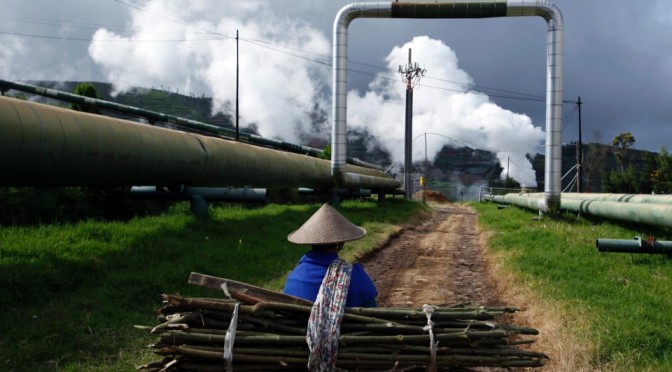Global climate change is happening and it is definitely real, the Intergovernmental Panel on Climate Change (IPCC) asserted in its latest report released in Yokohama, Japan, on March 31.
The most comprehensive assessment document to date by this UN Panel dedicated to providing the world with a state of knowledge in climate change shows impacts of global warming, which include a higher risk of flooding and
changes to crop yields and water availability.
Humans may be able to adapt to some of these changes, but only within limits. Human health, homes, food security and food safety are all likely to be threatened by rising global temperatures.
A 2-degree Celsius rise in global temperatures above pre-industrial levels by 2100 will threaten the world’s unique natural system and the risk is to increase to “very high”, such as melting of polar ice, bleaching of coral reefs, the ocean will become more acidic, many fish species will also move because of warmer waters causing potential fish catch in the tropics and in Antarctica to decline by more than 50 percent.
On land, mercury rises, crop yields for maize, rice and wheat will all be hit in the period up to 2050 with a projection of a 25 percent loss in production.
Two actions, climate adaptation and climate mitigation, should be taken by global communities. In climate mitigation, the world must rapidly move away from carbon-intensive fuels.
Fossil fuel from oil and coal should be replaced by natural gas, cleaner nuclear energy and geothermal energy. Also, there must be a “massive shift” to renewable energy including, solar energy, wind energy, wave energy and bio fuel.
Indonesia plays a dual role in climate change issues, taking its impact but also being able to provide solutions on global carbon absorption and in oxygen emission. Global warming takes its course in Indonesia with surface temperatures increasing from 0.2 to 0.3 of a degree Celsius per decade.
This impacts precipitation patterns, causing a wetter climate in Sumatra and Kalimantan but drier seasons in Java, Bali and Nusa Tenggara. Decreased rainfall during critical times of the year may increase high drought risk, while increased rainfall during already wet times of the year may lead to high flood risk.
Climate change in Indonesia will also produce stronger and more frequent El Niño/La Nina events and will exacerbate drying and/or flooding trends and could lead to decreased food production and increased hunger.
Meanwhile, due to global warming, the sea-level rise in the coastal areas of Indonesia will be increasing at the rate of 3-5 millimeter per year making more people at risk of flooding and seawater intrusion. Indonesia’s abundant biodiversity and ecosystem services are also threatened, 50 percent of its total biodiversity is at risk, 80 percent of its coral reefs are in severe condition because of warming sea-surface temperatures, sea level rise and other added stresses.
Climate change causes significant declines in fish larvae abundance and large-scale changes in fish habitat, such as skipjack tuna, while the massive coral bleaching leads to widespread loss of coral reefs and biodiversity, including the fish that many Indonesians rely on for food and livelihoods.
On land, more frequent forest fires are having significant impacts on Indonesia’s wildlife habitats and biodiversity and translating into serious economic and domestic as well as transboundary pollution consequences.
Impacts on human health are also inevitable. There are more frequent and severe heat waves, floods, extreme weather events and prolonged droughts leading to increased injury, illness and death. Infectious diseases, like malaria, dengue fever, diarrhea and severe respiratory problems following an increase of frequency and spread
of wild fires are some of the examples.
Indonesia’s adaptation measures have put a high priority on issues related to sea-level rise, increased extreme weather and threats to ecosystems and biodiversity.
More sustainable management options, such as more integrated agro-ecosystems, are being promoted both onshore and offshore. In the coastal areas, Integrated Coastal Zone Management (ICZM) programs are also being introduced by involving local governments.
In 2009, together with five other countries, Indonesia launched the Coral Triangle Initiative (CTI) to preserve and conserve their 75,000 square kilometers of coral reef resources from the impact of climate change and simultaneously strengthen their food security through ecosystem approach fisheries resources management.
Within the Global Environmental Facility (GEF) Cycle-5 Program, Indonesia and the UN Food & Agriculture Organization (FAO) have also embarked on an inland water fisheries biodiversity program and the large marine ecosystem of the Indonesian Seas Program.
Climate mitigation programs are also on the agenda. Energy diversification efforts are on the move by constructing solar cell power plants, increasing the percentage of bio fuel component into the gasoline consumption and encouraging the utilization of geothermal energy for power plants.
At the G20 Summit in Pittsburgh in September 2007, President Susilo Bambang Yudhoyono announced Indonesia’s voluntary CO2 emission reduction of 26 percent by 2020 and of 41 percent with international assistance.
About 52 percent of carbon emission reductions will be made in Indonesian forests and peat lands. In the meantime, two other potential Indonesian CO2 emission reduction components — mangroves and sea grasses — dubbed Blue Carbon, are also available to meet the targeted objectives.
Climate change is really important and many policy tools are available for dealing with this issue effectively.
However, resources must be mobilized. On April 16, 30 countries offered US$4.43 billion for the GEF 2014-2018 Programs to assist 140 developing countries, including Indonesia, to tackle issues related to climate change, biodiversity, oceans, lands, waters and food security.
Decisions will be made at the forthcoming GEF General Assembly in Cancun, Mexico, next month. Indonesia, in collaboration with multilateral organizations like the FAO, should embark on this endeavor for the preservation of our planet and for the benefits of its inhabitants.
The writer is director of fisheries and aquaculture resources division, Food and Agriculture Organization of the United Nations.


